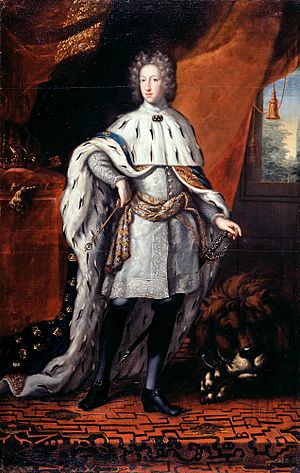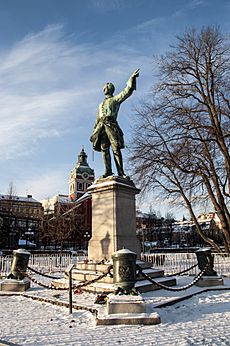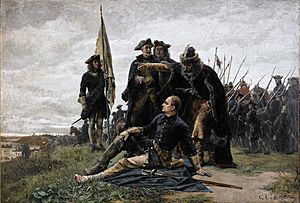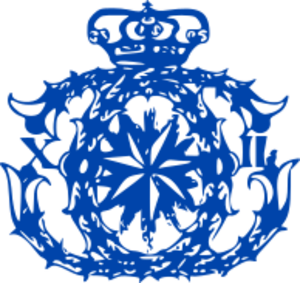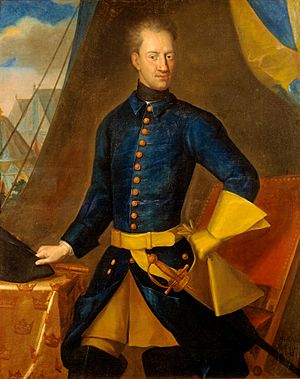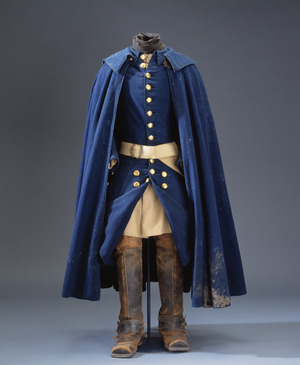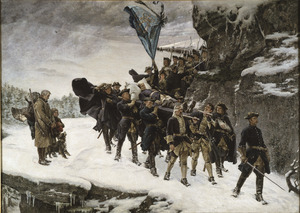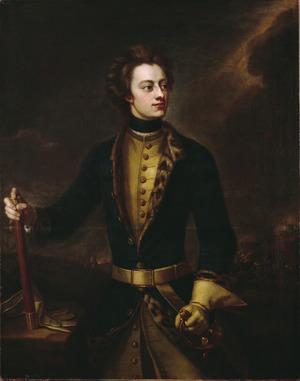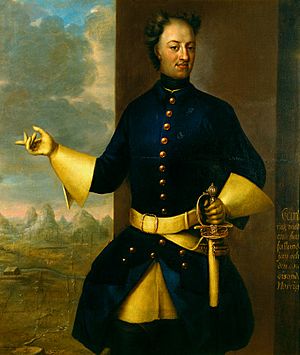Charles XII of Sweden facts for kids
Quick facts for kids Charles XII |
|
|---|---|
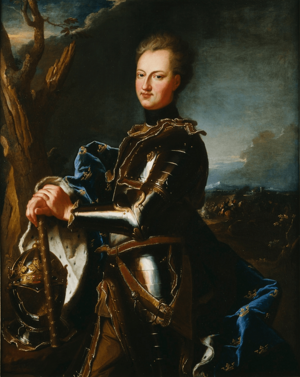
Portrait by Hyacinthe Rigaud c. 1715
|
|
| King of Sweden | |
| Reign | 5 April 1697 – 30 November 1718 O.S. |
| Coronation | 14 December 1697 |
| Predecessor | Charles XI |
| Successor | Ulrika Eleonora |
| Regent | Hedwig Eleonora of Holstein-Gottorp (5 April – 15 December 1697) |
| Born | 17 June 1682 Tre Kronor, Sweden |
| Died | 30 November 1718 (aged 36) Fredrikshald, Norway |
| Burial | 26 February 1719 Riddarholmen Church, Stockholm |
| House | Palatinate-Zweibrücken |
| Father | Charles XI of Sweden |
| Mother | Ulrika Eleonora of Denmark |
| Religion | Lutheran |
| Signature | |
Charles XII, also known as Carl XII or Carolus Rex, was the King of Sweden from 1697 to 1718. He was born on June 17, 1682, and passed away on November 30, 1718. Charles belonged to the House of Palatinate-Zweibrücken, a royal family branch. He was the only son of King Charles XI and Queen Ulrika Eleonora. Charles became king at just fifteen years old, after a short period of temporary government.
In 1700, a group of countries – Denmark–Norway, Saxony (which included Poland–Lithuania), and Russia – attacked the Swedish Empire. They thought Sweden was weak because it had a young, new king. This started the Great Northern War. Charles led the Swedish army and won many battles, even when his forces were much smaller.
One big victory was the Battle of Narva in 1700, where he defeated a Russian army three times larger. Russia's leader, Peter the Great, offered peace, but Charles said no. By 1706, Charles had made most of his enemies give up. Russia was the only powerful enemy left.
Charles then marched his army into Russia. He won early battles, like the Battle of Holowczyn, where his smaller army beat a Russian force twice its size. However, the campaign ended badly at the Battle of Poltava. Charles was injured before the battle and could not lead his troops. The Swedish army suffered huge losses.
After this defeat, Charles lived in exile in the Ottoman Empire for several years. He later returned to lead attacks on Norway. He hoped to make Denmark leave the war so he could focus on Russia. These campaigns failed, and Charles died during the Siege of Fredriksten in 1718. At this time, much of the Swedish Empire was taken over by other countries. This led to the end of the Swedish Empire and Sweden's absolute monarchy.
Charles was a very skilled military leader and a good politician. He made important changes to taxes and laws. He famously said he would "never start an unjust war but never end a legitimate one except by defeating my enemies." He spent more than half his life fighting wars. He never married or had children. His sister, Ulrika Eleonora, became queen after him.
Contents
Charles XII of Sweden
His Royal Title
Charles XII had a very long official title as king. It listed all the lands he ruled, including Sweden, Finland, and many other areas across Europe.
It's interesting to know that Charles was called "Charles XII," but he wasn't the 12th Swedish king named Charles. Earlier Swedish kings, like Erik XIV and Charles IX, chose their numbers based on old, mythical histories of Sweden. Charles XII was actually the 6th king named Charles.
The Great Northern War
Starting the War
Around 1700, the leaders of Denmark–Norway, Saxony (which included Poland-Lithuania), and Russia formed an alliance against Sweden. They thought Sweden was weak because its king, Charles, was young and new to the throne.
In early 1700, a Saxon army invaded Swedish Livonia and surrounded Riga. Russia also declared war in August 1700.
Charles's first fight was against Denmark–Norway, led by his cousin Frederick IV of Denmark. Charles got help from England and the Netherlands. He led 8,000 soldiers and 43 ships to invade Zealand. This quickly forced Denmark to sign the Peace of Travendal in August 1700.
After making peace with Denmark, Charles turned his attention to King August II of Saxony and Peter the Great of Russia. They had both joined the war against him.
Early Victories
Russia had invaded Swedish lands in Livonia and Estonia. Charles responded by attacking the Russian army at the Battle of Narva in November 1700. The Russians had almost four times more soldiers than the Swedish army of ten thousand. Charles attacked during a snowstorm, splitting the Russian army in two and winning the battle. About 10,000 Russian soldiers died, while Sweden lost 667 men.
Charles did not chase the Russian army. Instead, he went after Poland-Lithuania, which was officially neutral. Charles defeated the Polish king Augustus II and his allies at the Battle of Kliszow in 1702. He captured many cities. After removing Augustus as king of Poland, Charles put Stanisław Leszczyński on the Polish throne in 1704.
Russian Comeback
While Charles was winning battles in Poland, the Russian Tsar Peter the Great was making his army stronger. He used the Swedish army as a model. Russian forces managed to enter Ingria and built a new city there, Saint Petersburg.
Charles planned to invade Russia. He made an alliance with Ivan Mazepa, a leader of the Ukrainian Cossacks. Charles left Saxony in late 1707 with about 35,000 men. He also had 12,500 more troops joining from Livonia.
Charles won his "favorite" victory at the Battle of Holowczyn. He then decided to march towards Moscow instead of Saint Petersburg. However, Peter the Great ambushed one of Charles's armies at Lesnaya. This caused Charles to lose important supplies and many soldiers. Charles also expected help from a large Cossack rebellion led by Mazepa. But the Russians crushed this rebellion before the Swedes arrived. The harsh winter also hurt Charles's troops when they camped in Ukraine.
By the time of the important Battle of Poltava in July 1709, Charles had been wounded. He could not lead his army. His forces were much smaller than Tsar Peter's modernized army. The Swedish attack failed, and Charles fled south to the Ottoman Empire with a small group of soldiers. The rest of his army surrendered.
The Swedish defeat at Poltava was a major turning point. It marked the end of the Swedish Empire and the rise of the Russian Empire.
Exile in the Ottoman Empire
The Ottomans welcomed Charles XII at first. He found safety in a castle and later settled in Bender.
Charles sent messengers to Constantinople. They managed to contact Gülnuş Sultan, the mother of Sultan Ahmed III. She became interested in Charles and even wrote to him.
The Ottoman government paid for Charles's long stay. This is why he was nicknamed Demirbaş Şarl (Fixed Asset Charles) in Turkey. A small village called Karlstad was even built near Bender for the growing Swedish community.
Gülnuş Sultan convinced her son to declare war against Russia. Later, the Ottomans and Russians signed peace treaties. These treaties made Charles and his supporters unhappy, as they wanted the war to continue.
Eventually, the sultan's people grew tired of Charles's plans. His group also owed a lot of money to local merchants. Crowds attacked the Swedish camp at Bender. Charles had to defend himself against the mobs and Ottoman soldiers called Janissaries. This event was called "kalabalık," which means "crowd" in Turkish. It's now a Swedish word for a "ruckus." Charles was captured and put under house arrest. During this time, he played chess and studied Ottoman ships. His ideas even influenced the design of famous Swedish warships.
Meanwhile, Russia and Poland grew stronger. Great Britain turned against Sweden, and Prussia attacked Swedish lands in Germany. Russia occupied Finland. After more defeats, Finnish troops, administrators, and clergy fled Finland, which then came under Russian rule.
During his five years in the Ottoman Empire, Charles XII wrote to his sister, Ulrika Eleonora. He wanted a peace treaty that future Swedes would respect. He believed Sweden needed more respect in Europe to achieve this. The Swedish government and parliament tried to keep Sweden organized. In 1714, they sent Charles a warning letter. They told him that if he didn't return soon, they would make peace with Russia, Poland, and Denmark on their own. This made Charles rush back to Sweden.
Charles traveled back to Sweden with some Ottomans, including soldiers and businessmen he owed money to. He wrote a "free letter" for his Jewish and Muslim creditors so they could practice their religions in Sweden without trouble. Some soldiers chose to stay in Sweden.
Campaigns in Norway
Charles returned to Swedish Pomerania. He rode across Europe on horseback in just fifteen days. He arrived in Stralsund. A medal was made in 1714 to remember his fast ride. It said, "What worries you so? God and I live still."
After five years away, Charles found Sweden at war with many countries. Sweden's enemies attacked from the south and west. Russian forces moved through Finland to attack Stockholm. For the first time, Sweden was fighting a defensive war. Charles planned to attack Denmark by striking at its lands in Norway. He hoped this would make Denmark pull its forces out of Sweden.
Charles invaded Norway in 1716 with 7,000 men. He took the capital, Christiania (modern Oslo). He tried to capture the Akershus fortress there. But he didn't have enough heavy cannons. He had to retreat from the capital on April 29. In May, Charles invaded again, attacking Fredrikshald. He tried to capture the Fredriksten fortress. The Swedes faced heavy cannon fire and had to retreat when the Norwegians set the town on fire. Sweden lost about 500 men. During this time, the Swedish supply fleet was defeated in the Battle of Dynekilen.
In 1718, Charles invaded Norway again. With 40,000 men, he once more laid siege to the fortress of Fredriksten. Charles was killed during the siege while inspecting trenches. The invasion was stopped, and his body was returned to Sweden. Another Swedish force marched towards Trondheim but had to retreat. Many of these soldiers died in a severe winter storm.
Death of Charles XII
Charles XII was killed on November 30, 1718, while in the trenches near the Fredriksten fortress.
The exact details of his death are still unclear. Even after many investigations of the battlefield, his skull, and clothes, no one knows exactly where or when he was hit. It's also not known if the shot came from the enemy or his own men. There are several ideas about how Charles died, but none have strong enough proof. Many people were around the king, but no one saw the exact moment he was hit. One idea is that Dano-Norwegian soldiers killed him, as he was within range of their guns.
Other ideas suggest he was assassinated. One theory says a Swedish soldier, tired of the war, killed him. Another suggests an assassin hired by Charles's own brother-in-law, Frederick I of Sweden, who later became king. Frederick's aide, André Sicre, confessed while sick but later took back his confession. Some also suspect a plot by wealthy Swedes who didn't want Charles to introduce a new wealth tax. At the Varberg Fortress museum, there is a brass button filled with lead. Some claim this Swedish button was the object that killed the king.
A Finnish writer, Carl Nordling, shared an unusual story. He said the king's surgeon, Melchior Neumann, dreamed that the king told him he was shot not from the fortress, but from "one who came creeping."
Recent studies from the University of Oulu and University of Helsinki suggest Charles XII was likely killed by an enemy projectile.
Charles was succeeded as king by his sister, Ulrika Eleonora. His minister, Georg Heinrich von Görtz, was executed in 1719.
Personal Life
Charles XII never married and had no known children. When he was young, he was encouraged to find a wife to ensure the next king. But he often avoided talking about marriage. He said he would only marry someone he chose for love, not for political reasons. Some historians believe his strong religious faith might explain why he didn't have mistresses. Charles himself suggested he would not marry until peace was achieved, feeling "married" to his military life.
Legacy
People at the time said Charles had an amazing tolerance for pain and showed little emotion. His brilliant campaigns and surprising victories brought Sweden to its highest point of power. However, the Great Northern War eventually led to Sweden's defeat and the end of its empire soon after Charles's death.
Charles's death marked the end of kings ruling with absolute power in Sweden. The period after him, called the Age of Liberty, saw power shift from the king to the parliament. In the 19th century, Charles XII was seen as a national hero. He was admired as a brave, young warrior king. His fight against Peter the Great was linked to the rivalry between Sweden and Russia at the time. Famous works of art, like Esaias Tegnér's song Kung Karl, den unge hjälte (1818) and Gustaf Cederström's painting Karl XII:s likfärd (1878), showed him as a hero.
In the 1930s, Swedish Nazis held celebrations on the date of Charles XII's death. Before World War II, Adolf Hitler even received a sculpture of the king as a birthday gift from Sweden. In recent times, Swedish nationalists and neo-Nazis have used November 30 for their ceremonies. However, these events are often met with larger counter-protests and have been stopped.
Scientific Interests
Besides being a king, Charles was interested in mathematics. He liked anything that could help with his military goals. He is believed to have invented an octal numeral system (base 8). He also thought about a base 64 system, which he felt was better for war because gunpowder boxes were cubic. A scientist named Emanuel Swedenborg reported that the King sketched his ideas on paper in 1716. This paper was reportedly still around a hundred years later but is now lost.
Books About Charles XII
Charles fascinated many people. In 1731, Voltaire wrote a biography called History of Charles XII. Voltaire showed the Swedish king in a good light, comparing him to the harsh nature of Peter the Great.
Swedish author Frans G. Bengtsson and Professor Ragnhild Hatton have also written biographies about Charles XII. He also appears in Robert Massie's book Peter the Great.
See also
 In Spanish: Carlos XII de Suecia para niños
In Spanish: Carlos XII de Suecia para niños
- Gottorp Fury
Images for kids


